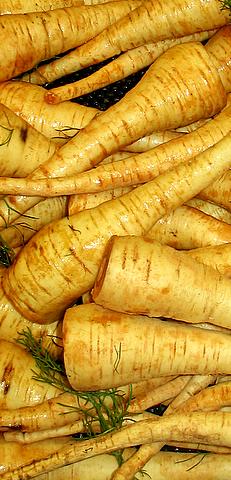Parsnip
| Parsnip | ||||||||||||||
|---|---|---|---|---|---|---|---|---|---|---|---|---|---|---|
 A selection of parsnips
|
||||||||||||||
| Scientific classification | ||||||||||||||
|
||||||||||||||
| Binomial name | ||||||||||||||
| Pastinaca sativa L.[1] |
The parsnip (Pastinaca sativa) is a root vegetable related to the carrot. Parsnips resemble carrots, but are paler than most of them and have a stronger flavor. Like carrots, parsnips are native to Eurasia and have been eaten there since ancient times. Zohary and Hopf note that the archeological evidence for the cultivation of the parsnip is “still rather limited,” and that Greek and Roman literary sources are a major source about its early use, but warn "there are some difficulties in distinguishing between parsnip and carrot (which, in Roman times, were white or purple) in classical writings since both vegetables seem to have been sometimes called pastinaca yet each vegetable appears to be well under cultivation in Roman times."[2]
Contents |
Uses
Until the potato arrived from the New World, its place in dishes was occupied by the parsnip and other root vegetables such as the turnip. Parsnips can be boiled, roasted or used in stews, soups and casseroles. In some cases, the parsnip is boiled and the solid portions are removed from the soup or stew, leaving behind a more subtle flavour than the whole root and contributing starch to thicken the dish. Roasted parsnip is considered an essential part of Christmas dinner in some parts of the English-speaking world and frequently features in the traditional Sunday Roast. Parsnips can also be fried, or be eaten raw.
The parsnip originates in the Mediterranean region and originally was the size of a baby carrot when full grown. When the Roman Empire expanded north through Europe the Romans brought the parsnip with them. They found that the parsnip grew bigger the further north they went.
Name
While folk etymology sometimes assumes the name is a portmanteau of parsley and turnip, it actually comes from a Latin word for "forked", plus the -nip ending because it was assumed to be a kind of turnip. It is among the closest relatives of actual parsley, which can be bred to develop a very parsnip-like root.
Cultivation
Parsnips are not grown in warm climates, since frost is necessary to develop their flavor. The parsnip is a favorite with gardeners in areas with short growing seasons. Sandy, loamy soil is preferred; silty, clay, and rocky soils are unsuitable as they produce short forked roots.
Seeds can be planted in early spring, as soon as the ground can be worked. Harvesting can begin in late fall after the first frost, and continue through winter until the ground freezes over.
More than almost any other vegetable seed, parsnip seed significantly deteriorates in viability if stored for long, so it is advisable to use fresh seed each year.
In Roman times, parsnips were believed to be an aphrodisiac.
In the United States, this plant was introduced fairly early in history by British colonists as a root vegetable. It was thereafter replaced in popularity by the potato in the mid-nineteenth century and consequently escaped from cultivation, so today most states have wild parsnip on their list of noxious weeds or invasive species.
Parsnip is used as a food plant by the larvae of some Lepidoptera species, including its namesake, the Parsnip swallowtail and also the Common Swift, Garden Dart, and Ghost Moth.
Nutritional properties
The parsnip is richer in vitamins and minerals than its close relative the carrot. It is particularly rich in potassium with 600 mg per 100 g. The parsnip is also a good source of dietary fiber. 100 g of parsnip contains 55 calories (230 kJ) energy.
Some people can have an allergic reaction to parsnip, and parsnip leaves may irritate the skin.
Dangers connected to wild parsnips
Wild parsnip causes phytophotodermatitis[3] and must be handled with full-body protection. If skin is exposed to wild parsnip it is necessary to go inside within the next 10 minutes and stay there for 6-8 hours. Skin will not be affected by artificial light.
When picking wild vegetables it is easy to mistake poison hemlock (Conium maculatum) for parsnip with deadly results. All parts of this hemlock are poisonous: leaves, stem, roots, and fruit. Poison hemlock contains volatile alkaloids that have been used as poisons since ancient times. The best way to differentiate it from parsnip are purple streaks and blotches on a smooth hairless stem. Other ways include the small wispy flowers and fernlike leaves which vary slightly from those on the parsnip.
References
- ↑ "Pastinaca sativa information from NPGS/GRIN". www.ars-grin.gov. Retrieved on 2008-03-02.
- ↑ Daniel Zohary and Maria Hopf, Domestication of plants in the Old World, third edition (Oxford: University Press, 2000), p. 203
- ↑ Phytophotodermatitis associated with parsnip picking
- Dr D.G. Hessayon (2003) The Vegetable & Herb Expert. Expert Books. ISBN 0-903505-46-0
- Dr. Mary Robson (1999) Poison Hemlock : Dangerous to People and Animals". Washington State University Online Directory
- Adam Hart-Davis (2001) What did the Romans do for us?. BBC TV
External links
- Pastinaca sativa profile on the USDA plants database
- Pastinaca sativa profile on missouriplants.com
- Recipes with parsnips
- Pastinaca sativa List of Chemicals (Dr. Duke's)